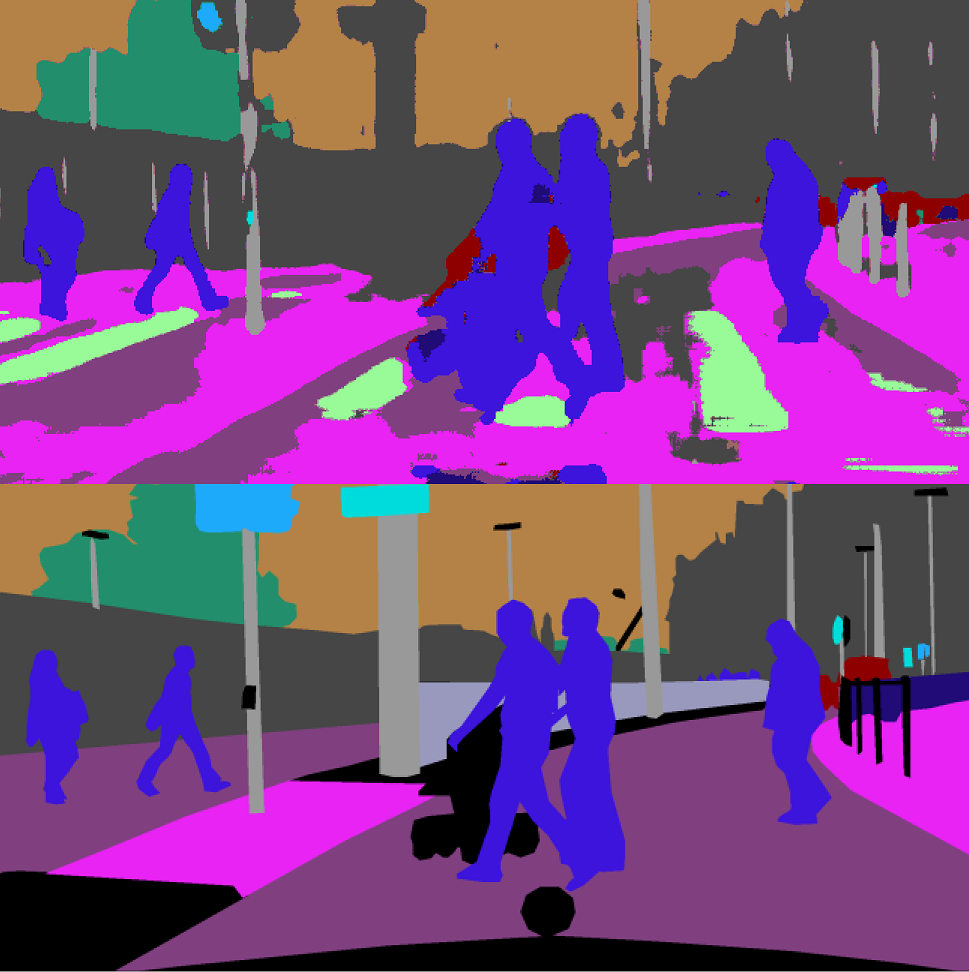Using FlowNet for training a PSPNet - Boschert L, Ging S, Siemund H - 03.02.19
Prediction example:
Link to the paper and code: https://hszhao.github.io/projects/pspnet/
Link to code on which this project was based: https://github.com/ykamikawa/PSPNet.
# ----- Requirements:
# python 3.5
# Cuda 8.0.61
# tensorflow-gpu==1.8, keras==2.1.0, h5py==2.9, opencv-python, matplotlib
virtualenv --system-site-packages -p python3 venv3
source venv3/bin/activate
pip install tensorflow-gpu==1.8
pip install keras==2.1.0
pip install h5py==2.9
pip install opencv-python
pip install matplotlib
- Download labels at https://www.cityscapes-dataset.com/downloads/
gtFine_trainvaltest.zip (241MB) and extract them
-
Download the video frame sequences
leftImg8bit_sequence_trainvaltest.zip (324GB), do not extract -
extract images from video dataset zip file with
python handle_dataset.py -
find and copy corresponding labels
python handle_dataset.py --labels -
copy only the first frame of all images into another folder
python handle_dataset.py --singles
-
Install FlowNet3: https://github.com/lmb-freiburg/netdef_models
-
Apply it on the dataset and get the raw flow
-
Compress it
python handle_flow.py --compress
# This creates: train.csv, val.csv, test.csv
python compute_class_weights.py
the flow minimum and maximum values per axis are in the csv files
# default dataset folder: datasets/city_full/
# csvs for splits
test.csv
train.csv
val.csv
# computed balanced weights
weights_categories.json
weights_labels.json
# image folder (with frame 19, without any more subfolders than these)
images/test/
images/train/
images/val/
# flow folder (with compressed flows, motion bounds, occlusions)
flow/test/
flow/train/
flow/val/
# labels
labels_ids/train/
labels_ids/val/
# color coded labels folders (like labels_color) are only there for
# visualization but currently not used by the program
Important flags when running python train.py
--model_name model1 # name models
--use_flow # use additional optical flow input
--use_occ # occlusions
--use_mb # motion boundaries
--restart # restarts model from epoch 0 instead of reloading
--unbal_xlast # disable weight balancing
--train_categories # train on 8 categories instead of 20 classes
--use_cpu # no gpu
--use_random # random data input instead of dataset (to test)
Use the same arguments for python test.py as for training (including weight balancing flags).
--full_size to run predictions and metrics on full size images (2048x1024)
Test results:
-
logs/model_name/predcontains first 10 predictions and ground truths. -
result_test/model_namecontains first 10 inputs (images, flow etc.)
python plot_stuff.py --plot_from_config
python array_to_img.py
Results will be stored in result_vis/
- 2048x1024 RGB Images
- Flow predicted with 2 frames within 60ms distance
- Flow is saved as 2 grayscale images
- random resampling (0.5 to 2.0)
- random crop to (512x512)
Unfortunately in the PSPNet paper they did not say much about their optimization process.
We used adadelta with default values of keras: keras.optimizers.Adadelta(lr=1.0, rho=0.95, epsilon=1e-6)
We took the model source (first link in this document) baseline which was batch size 4, 10 epochs, 6000 steps. This results to 240,000 datapoints evaluated per model.
Overview https://www.cityscapes-dataset.com/dataset-overview/#features
Details https://github.com/mcordts/cityscapesScripts/blob/master/cityscapesscripts/helpers/labels.py
- Mapping is done in utils/labels.py from 33 input classes to 20 training classes
- For trainid=19, we do not train or predict (weight zero).
We used weimar and zurich for validation and all others that have labels and have 30-frame clips for training.
- mean iou report per epoch is incorrect
